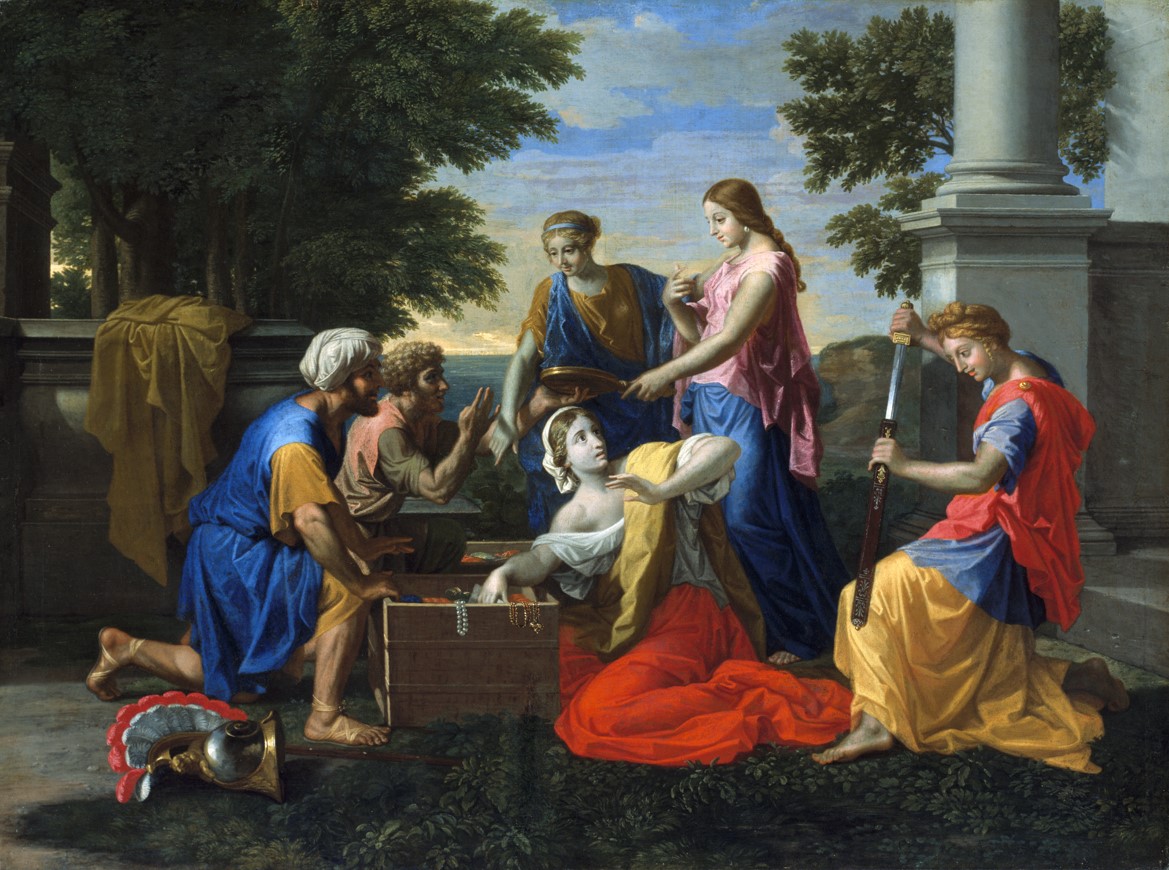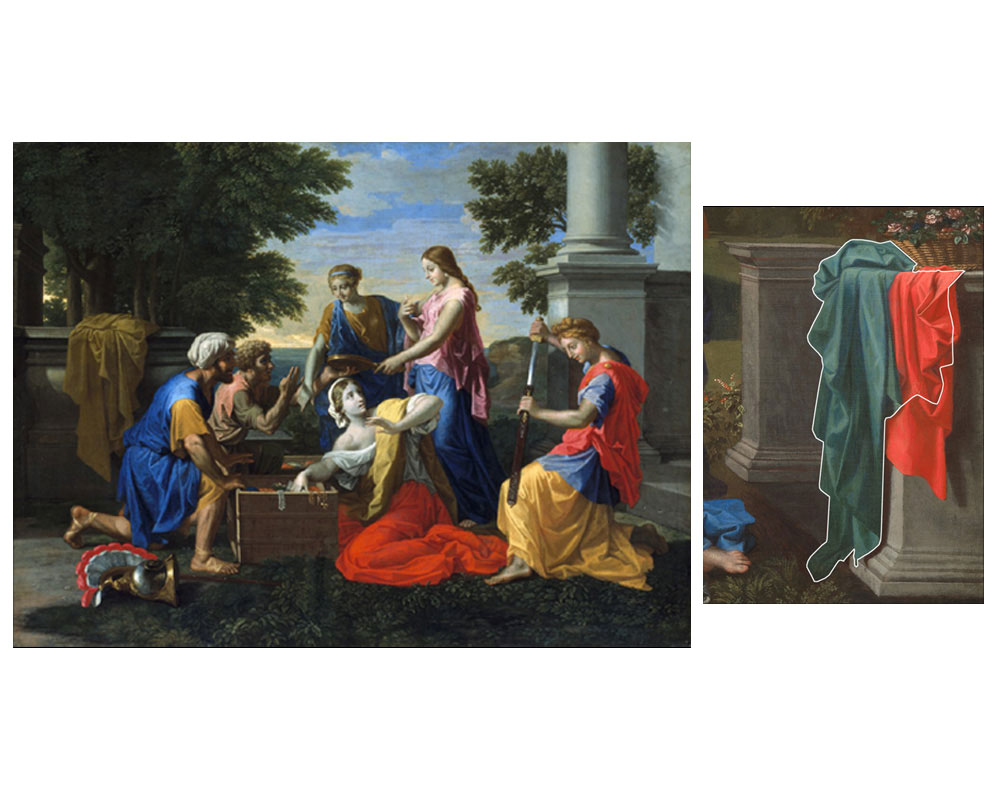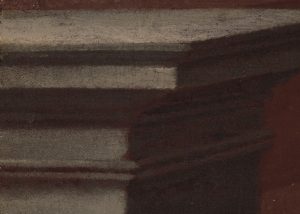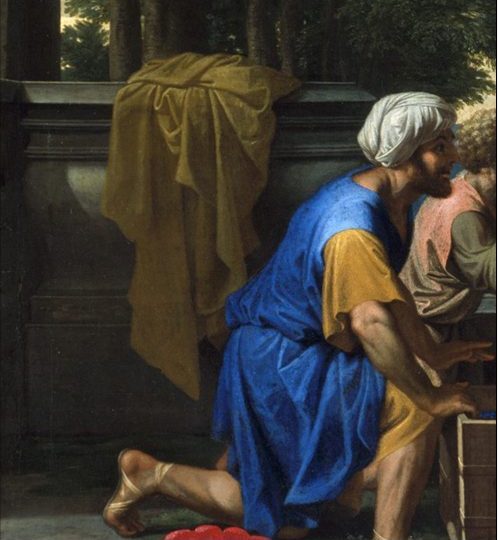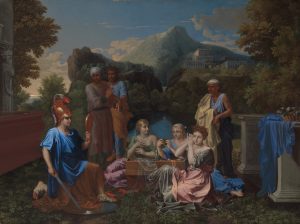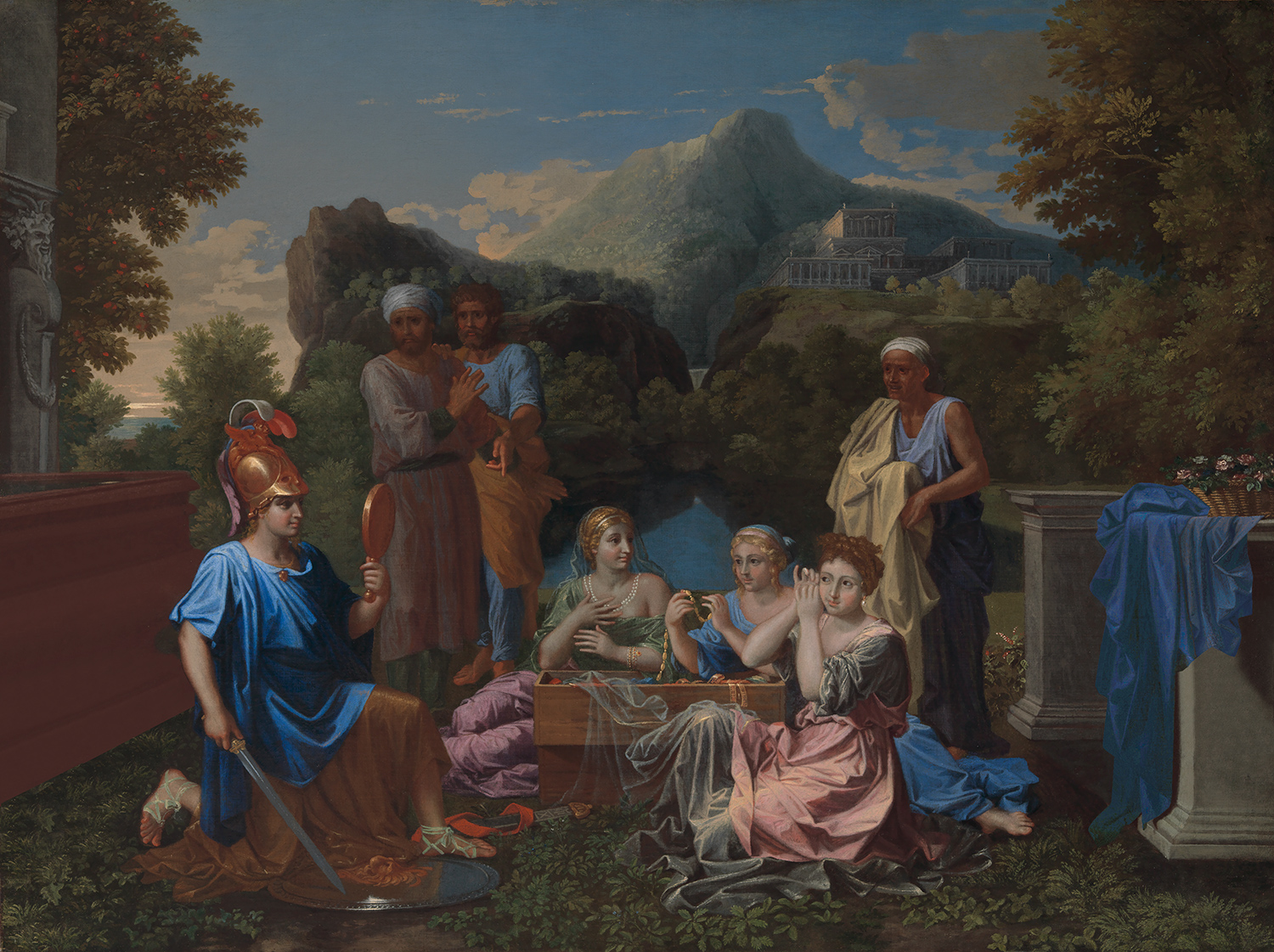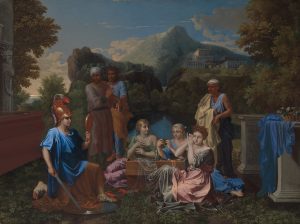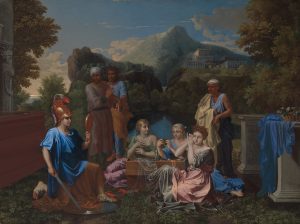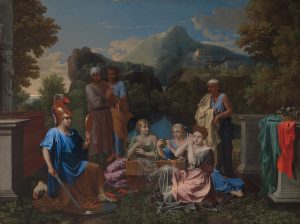By Carol Sawyer, Margaret H. & William E. Massey Sr. Conservator of Paintings
The Painting Conservation Department performs treatments, examinations and research related to the VMFA painting collection. In the course of doing this work questions regarding the authenticity of a work of art sometimes arise. Technical analysis and
in-depth examination of the materials and techniques used by an artist can answer attribution issues and resolve authenticity questions.

Fig. 1 Nicolas Poussin, Achilles among the Daughters of Lycomedes (or Achilles on Skyros), 1656; oil on canvas, 100.33 x 133.35 cm. Virginia Museum of Fine Arts, Richmond, Arthur G. and Margaret B. Glasgow Fund, 57.2.
An important painting in the VMFA collection, Achilles among the Daughters of Lycomedes [Fig. 1] , by the 17th C. French artist, Nicolas Poussin, was thought by numerous art historians to be a period copy and not an authentic work. Scholars questioned the painting’s authenticity after VMFA purchased the painting in 1957. Exhaustive research conducted decades later by Carol Sawyer, VMFA’s Margaret H. and William E. Massey Sr. Conservator of Paintings, revealed that VMFA’s Achilles was an original late work by this great French artist.
The picture, executed in 1656, was acquired by VMFA from Wildenstein and Company in New York. The subject depicts the popular Greek legend of Ulysses’s discovery of Achilles disguised as a female in the company of the daughters of King Lycomedes on the island of Skyros.
For most of the nineteenth century, and up through the mid-twentieth century, little was known about the painting’s whereabouts. However, scholars were aware of the painting’s existence from a contemporary engraving, after Poussin, executed by Pietro del Po (1610–1692) [Fig. 2], and through early documents that refer to and describe this composition. During this period the painting was referred to as the “lost Achilles.”
An earlier version of the same subject by Poussin, Discovery of Achilles on Skyros painted circa 1649–50 [1650], is in the collection of The Museum of Fine Arts in Boston [Fig. 3].
Before acquiring the painting VMFA asked Walter Friedländer, a Poussin scholar, to assess the painting and offer an expert opinion regarding its quality. Friedländer identified the painting as the “lost Achilles” and accepted it not only as an authentic work by Poussin but also as an “impressive” example of his mature style.
Unfortunately, not all scholars concurred with Friedländer; some concluded that the painting was a period copy or a work in poor condition and the painting’s “reputation” suffered as a result. Technical analysis was conducted in order to clear up any doubts regarding its authorship.
Technical examination included visual, stereoscopic, x-radiographic and infrared reflectographic examination, as well as limited pigment and cross section analysis. This research provided a great deal of comparative material that was used to determine if VMFA’s Achilles was similar to other paintings by the artist. The canvas type and weave, ground materials, pigments, glazes, and layering structure in the ground and paint film were present in other works by the artist and typical of the materials and techniques he employed. Unique characteristics in the x-radiograph, related to the artist’s specific working method, were also found in other x-radiographs of paintings executed in his early, middle, and late period.
These changes indicate that the artist was not satisfied with the initial color and configuration of several compositional elements as well as their placement. While Poussin made numerous changes throughout, the three most significant modifications, present on the right and left sides of the composition, are outlined below.
At an early stage, there was a single piece of blue drapery hanging over the pedestal on the right, instead of the red and green drapery currently visible. The general shape of this preliminary blue drapery was determined by tracing the outside edges of the blue paint layer that is visible under high magnification in slightly abraded areas in the paint film [Fig. 4a, Fig. 4b].
The blue paint layer was present under all of the green drapery (ending at the fabric edges) and under the top two thirds of the red drapery [Fig. 5b]. The outline that was formed by the tracing revealed that the shape of the fabric was not unlike the yellow fabric in Boston’s Achilles, only depicted in reverse [Fig. 5a]. At this stage in the evolution of the composition, VMFA’s Achilles mimicked Boston’s Achilles in that both contain a single piece of fabric draped over an architectural element.
Other modifications were made on the left side of the VMFA composition. Again, as in the Boston version, the water basin in VMFA’s Achilles initially stood alone, without a pedestal in front of it. Evidence of this is visible in the deep shadows of the pedestal where the reddish brown brushstrokes of the water basin can be seen beneath the grey paint layer [Fig. 6]. This is also evident in the x-radiograph. Radio-opaque and radio-transparent brushstrokes defining the contours of the water basin continue through the paint layer that depicts the pedestal, ending at the very left edge of the canvas [Fig. 7].
The white outline denotes the first water basin (similar to Boston’s) and the red outline denotes the second and final water basin [Fig. 8]. The basin’s original contours were also curved [Fig. 8], as are the contours of the basin in the Boston composition [Fig. 9]. In addition, the basin was not as deep, with the bottom of the basin aligning more closely with Achilles’s elbow [Fig. 8].
These findings revealed that Poussin borrowed various ideas and motifs from his earlier 1650 work only to adjust them while executing the later 1656 painting.
In evaluating the possible rationale behind these changes it is clear that the reworking of the basin’s shape and size, and the addition of the pedestal on the left, greatly improved the visual balance of the composition. In addition, these important changes created a greater sense of space and depth of field as the viewer’s eye wanders through the landscape, from foreground to background. Finally, the modifications made by Poussin regarding the color scheme on the far right greatly enhanced the chromatic balance of the composition.
Fig. 10, Fig. 11 Digitally edited photos of Achilles among the Daughters of Lycomedes. Virginia Museum of Fine Arts, Richmond, edited to demonstrate what the painting might have looked like during earlier iterations.As previously illustrated in the x-radiograph Poussin’s initial configuration included a shallow curved water basin. The artist most likely decided to change this initial design because it lacked the weight required to balance the elements on the far right [Fig. 10]. To address this imbalance Poussin made a few modifications, changing the shape and size of the water basin by squaring off the curved contour near the top and increasing the overall height, making the basin deeper [Fig. 11].
While these initial modifications made the basin appear more massive from a visual standpoint this solution was not entirely satisfactory; the compositional imbalance remained.
A second and final attempt to correct this problem was successful. Poussin added a gray pedestal to the left foreground directly opposite the pedestal on the far right. This architectural prop adequately anchors the compositional elements on the far left, adding the visual weight so desperately needed. Also the basin and pedestal, taken with the two other pedestals on the right, perfectly frame the event, focusing the viewer’s attention on the story and the intriguing individual actions of the figures.
One other change, regarding the overall palette, was made as well. To achieve a more harmonious and balanced color scheme the artist changed the blue drapery on the pedestal, adding a soft green and vibrant red, successfully toning down the abundant blue in the composition.
The following photos illustrate the evolution of the composition.
Click each thumbnail below to display the progression of changes in the painting
The pentiments discovered in the x-radiograph, as well as the pictorial changes found while examining the paint layers under magnification, clearly indicate that the painting is not a period copy. When an artist is copying a painting the intention is to accurately replicate what is seen on the surface. Consequently compositional changes in design, order and or color are not present. The modifications in VMFA’s Achilles represent the creative process that can occur while an artist is composing an original work.
It is often necessary to pursue multiple analytical avenues to resolve uncertainty related to the authenticity of a work of art. The data gathered through the application of this process often provides enough information to remove all doubts.
Additional research related to VMFA’s Achilles and the authorship problem will be shared in future updates.

